Insertion Sort Implementation in C++
- The Tech Platform

- Nov 2, 2020
- 1 min read
#include <stdlib.h>
#include <iostream>
using namespace std;
//member functions declaration
void insertionSort(int arr[], int length);
void printArray(int array[], int size);
// main function
int main()
{
int array[6] = {5, 1, 6, 2, 4, 3};
// calling insertion sort function to sort the array
insertionSort(array, 6);
return 0;
}
void insertionSort(int arr[], int length)
{
int i, j, key;
for (i = 1; i < length; i++)
{
key = arr[i];
j = i-1;
while (j >= 0 && arr[j] >key)
{
arr[j+1] = arr[j];
j--;
}
arr[j +1] = key;
}
cout << "Sorted Array: ";
// print the sorted array
printArray(arr, length);
}
// function to print the given array
void printArray(int array[], int size)
{
int j;
for (j = 0; j < size; j++)
{
cout <<" "<< array[j];
}
cout << endl;
}Complexity Analysis of Insertion Sort
Even though insertion sort is efficient, still, if we provide an already sorted array to the insertion sort algorithm, it will still execute the outer for loop, thereby requiring n steps to sort an already sorted array of n elements, which makes its best case time complexity a linear function of n.
Worst Case Time Complexity [ Big-O ]: O(n2)
Best Case Time Complexity [Big-omega]: O(n)
Average Time Complexity [Big-theta]: O(n2)
Space Complexity: O(1)
Resource: Studytonight.com
Interviewbit.com
The Tech Platform






Comments